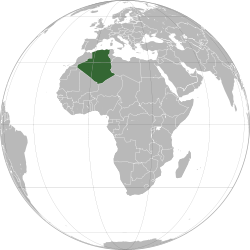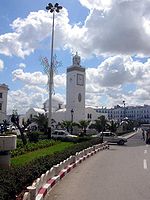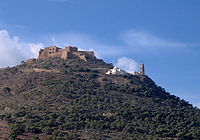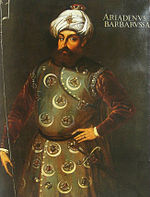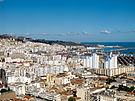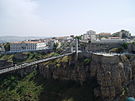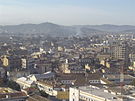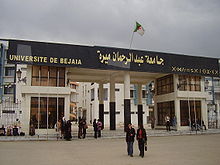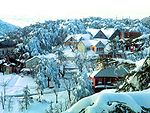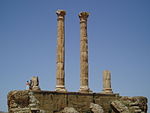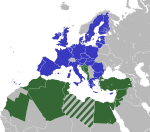- Algeria
-
"Algérie" redirects here. For the French WWII heavy cruiser, see French cruiser Algérie.
Coordinates: 29°34′24″N 2°22′23″E / 29.5734571°N 2.3730469°E
People's Democratic Republic of Algeria 

Flag Emblem Motto: " بالشّعب وللشّعب " (Arabic)
S weɣref i weɣref (Berber)
"By the people and for the people"[1][2]Anthem:
"Kassaman"
We PledgeCapital
(and largest city)Algiers
36°42′N 3°13′E / 36.7°N 3.217°EOfficial language(s) Arabic[3] National languages Berber Demonym Algerian Government Semi-presidential republic - President Abdelaziz Bouteflika - Prime Minister Ahmed Ouyahia History - Berber kingdom of Numidia from 202 BC - Roman Republic from 46 BC - Vandal Kingdom from 430 - Rustamid dynasty from 767 - Zirid dynasty from 973 - Hammadid dynasty from 1014 - Abdalwadid dynasty from 1235 - Ottoman Empire from 1516 - French rule from 1830 - Independence from France 3 July 1962 (recognized by France) - Independence from France 5 July 1962 (declared by Algeria) Area - Total 2,381,741 km2 (10th)
919,595 sq mi- Water (%) negligible Population - 2010 estimate 36,423,000[4] - 1998 census 29,100,867 - Density 14.6/km2 (204th)
37.9/sq miGDP (PPP) 2010 estimate - Total $251.705 billion[5] - Per capita $6,965[5] GDP (nominal) 2010 estimate - Total $157.759 billion[5] - Per capita $4,366[5] Gini (1995) 35.3[6] (medium) HDI (2011)  0.698[7] (medium) (96th)
0.698[7] (medium) (96th)Currency Algerian dinar ( DZD)Time zone CET (UTC+01) Drives on the right ISO 3166 code DZ Internet TLD .dz, الجزائر. Calling code 213 Modern Standard Arabic is the official language.[8]
Tamazight is spoken by one third of the population and has been recognized as a "national language" by the constitutional amendment since 8 May 2002.[9] Algerian Arabic (or Darja) is the language used by the majority of the population. Although French has no official status, Algeria is the second Francophone country in the world in terms of speakers[10] and French is still widely used in the government, the culture, the media (newspapers) and the education system (since primary school), due to Algeria's colonial history and can be regarded as the de facto co-official language of Algeria. The Kabyle language, the most-spoken Berber language in the country, is taught and is partially co-official (with a few restrictions) in parts of Kabylia.Algeria
 i/ælˈdʒɪəriə/ (Arabic: الجزائر, al-Jazā'ir; Berber and Algerian Arabic: Dzayer or Ldzayer), officially the People's Democratic Republic of Algeria (Al Jumhuriyah al Jazairiyah ad Dimuqratiyah ash Shabiyah), also formally referred to as the Democratic and Popular Republic of Algeria,[11] is a country in the Maghreb region of Northwest Africa with Algiers as its capital.
i/ælˈdʒɪəriə/ (Arabic: الجزائر, al-Jazā'ir; Berber and Algerian Arabic: Dzayer or Ldzayer), officially the People's Democratic Republic of Algeria (Al Jumhuriyah al Jazairiyah ad Dimuqratiyah ash Shabiyah), also formally referred to as the Democratic and Popular Republic of Algeria,[11] is a country in the Maghreb region of Northwest Africa with Algiers as its capital.In terms of land area, it is the largest country in Africa, the Arab World and of the countries bordering the Mediterranean Sea; it is also the tenth-largest country in the world.[12] The country is bordered in the northeast by Tunisia, in the east by Libya, in the west by Morocco, in the southwest by Western Sahara, Mauritania, and Mali, in the southeast by Niger, and in the north by the Mediterranean Sea. Its size is almost 2,400,000 square kilometres (926,645 sq mi) with an estimated population of 36.3 million as of 2011.[13]
Algeria is a member of the African Union, the Arab League, OPEC and the United Nations. The country is also a founding member of the Arab Maghreb Union.
Etymology
The country's name is derived from the city of Algiers. The most common etymology links the city name to al-Jazā'ir (الجزائر, "The Islands"), a truncated form of the city's older name Jazā'ir Banī Mazghanna (جزائر بني مزغنة, "Islands of the Mazghanna Tribe"),[14][15] employed by medieval geographers such as al-Idrisi. Others[who?] trace it to Ldzayer, the Maghrebi Arabic and Berber for "Algeria" possibly related to the Zirid Dynasty King Ziri ibn-Manad and founder of the city of Algiers[16] Ziri itself means "Moonlight" in Berber.[citation needed]
History
Main article: History of AlgeriaAncient Numidia
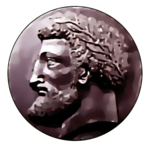 Massinissa, the most famous king of Numidia
Massinissa, the most famous king of Numidia
In Antiquity, Algeria was known as the kingdom of Numidia and its people were called the Numidians. The kingdom of Numidia had early relations with the Carthaginians, Romans and Ancient Greeks, the region was considered a fertile area, and the Numidians were known for their fine cavalry.[citation needed]
The indigenous peoples of northern Africa are a distinct native population, the Berbers.[17]
After 1000 BCE, the Carthaginians began establishing settlements along the coast. The Berbers seized the opportunity offered by the Punic Wars to become independent of Carthage, and Berber kingdoms began to emerge, most notably Numidia.[citation needed]
In 200 BCE, they were once again taken over, this time by the Roman Republic. When the Western Roman Empire collapsed in 476 CE, the Berbers became independent again in many regions, while the Vandals took control over other areas, where they remained until expelled by the Byzantine general Belisarius under the direction of Emperor Justinian I. The Byzantine Empire then retained a precarious grip on the east of the country until the coming of the Arabs in the 8th century.[citation needed]
Middle Ages
The Berber people controlled much of the Maghreb region throughout the Middle Ages. The Berbers were made up of several tribes. The two main branches were the Botr and Barnès tribes, who were themselves divided into tribes, and again into sub-tribes. Each region of the Maghreb contained several tribes (for example, Sanhadja, Houaras, Zenata, Masmouda, Kutama, Awarba, and Berghwata). All these tribes were independent and made territorial decisions.[18]
Several Berber dynasties emerged during the Middle Ages in Maghreb, Sudan, Andalusia, Italy, Mali, Niger, Senegal, Egypt, and other nearby lands. Ibn Khaldun provides a table summarizing the Zirid, Banu Ifran, Maghrawa, Almoravid, Hammadid, Almohad, Merinid, Abdalwadid, Wattasid, Meknassa and Hafsid dynasties.[19]
Arrival of Islam
When Muslim Arabs arrived in Algeria in the mid-7th century, a large number of locals converted to the new faith. After the fall of the Umayyad Arab Dynasty in 751, numerous local Berber dynasties emerged. Amongst those dynasties were the Aghlabids, Almohads, Abdalwadid, Zirids, Rustamids, Hammadids, Almoravids and the Fatimids.
Having converted the Berber Kutama of the Lesser Kabylia to its cause, the Shia Fatimids overthrew the Rustamids, and conquered Egypt, leaving Algeria and Tunisia to their Zirid vassals. When the latter rebelled, the Shia Fatimids sent in the Banu Hilal and Banu Sulaym Arabian tribes who unexpectedly defeated the Zirids.
Spanish enclaves
See also: Oran#Spanish periodThe Spanish fort of Santa Cruz, Oran
The Spanish expansionist policy in North Africa began with the rule of the Catholic monarchs Isabella I of Castile and Ferdinand II of Aragon and their regent Cisneros, once the Reconquista of the Iberian Peninsula was completed, several towns and outposts on the Algerian coast were conquered and occupied by the Spanish Empire: Mers El Kébir (1505), Oran (1509), Algiers (1510) and Bugia (1510). On 15 January 1510 the King of Algiers, Samis El Felipe,[clarification needed] was forced into submission by the king of Spain. King El Felipe[clarification needed] called for help from the corsairs Hayreddin Barbarossa and Oruç Reis who previously helped Andalusian Muslims and Jews escape from Spanish oppression in 1492. In 1516, Oruç Reis conquered Algiers with the support of 1,300 Turkish soldiers on board 16 galliots and became its ruler, with Algiers joining the Ottoman Empire.
The Spaniards left Algiers in 1529, Bugia in 1554, Mers El Kébir and Oran in 1708. The Spanish returned in 1732 when the armada of the Duke of Montemar was victorious in the Battle of Aïn-el-Turk; Spain recaptured Oran and Mers El Kébir. Both cities were held until 1792, when they were sold by King Charles IV of Spain to the Bey of Algiers.
Barbary Pirates
 Five British escaping slavery from Algiers
Five British escaping slavery from Algiers
 French friars buying back French slaves.
French friars buying back French slaves.
Algeria was made part of the Ottoman Empire by Hayreddin Barbarossa and his brother Aruj in 1517. After the death of Oruç Reis in 1518, his brother succeeded him. The Sultan Selim I sent him 6,000 soldiers and 2,000 janissaries with which he conquered most of the Algerian territory taken by the Spanish, from Annaba to Mostaganem. Further Spanish attacks led by Hugo of Moncada in 1519 were also pushed back. In 1541, Charles V, emperor of the Holy Roman Empire, attacked Algiers with a convoy of 65 warships, 451 large ships and 23,000 men, 2000 of whom were mounted. The attack resulted in failure however, and the Algerian leader Hassan Agha became a national hero as Algiers grew into a center of military power in the Mediterranean.[citation needed]
The Ottomans established Algeria's modern boundaries in the north and made its coast a base for the Ottoman corsairs; their privateering peaked in Algiers in the 17th century. Piracy on American vessels in the Mediterranean resulted in the First (1801–1805) and Second Barbary Wars (1815) with the United States. The pirates forced the people on the ships they captured into slavery; when the pirates attacked coastal villages in southern and Western Europe the inhabitants were forced into the Arab slave trade.[20]
The Barbary pirates, also sometimes called Ottoman corsairs or the Marine Jihad (الجهاد البحري), were Muslim pirates and privateers that operated from North Africa, from the time of the Crusades until the early 19th century. Based in North African ports such as Tunis in Tunisia, Tripoli in Libya and Algiers in Algeria, they preyed on Christian and other non-Islamic shipping in the western Mediterranean Sea.[citation needed]
Their stronghold was along the stretch of northern Africa known as the Barbary Coast (a medieval term for the Maghreb after its Berber inhabitants), but their predation was said to extend throughout the Mediterranean, south along West Africa's Atlantic seaboard, and into the North Atlantic as far north as Iceland and the United States. They often made raids, called Razzias, on European coastal towns to capture Christian slaves to sell at slave markets in places such as Turkey, Egypt, Iran, Algeria and Morocco.[21][22] According to Robert Davis, from the 16th to 19th century, pirates captured 1 million to 1.25 million Europeans as slaves. These slaves were captured mainly from seaside villages in Italy, Spain and Portugal, and from farther places like France, England, Ireland, the Netherlands, Germany, Poland, Russia, Scandinavia and even Iceland, India, Southeast Asia and North America.[citation needed]
The impact of these attacks was devastating – France, England, and Spain each lost thousands of ships, and long stretches of coast in Spain and Italy were almost completely abandoned by their inhabitants. Pirate raids discouraged settlement along the coast until the 19th century.[citation needed]
The most famous corsairs were the Ottoman Barbarossa ("Redbeard") brothers –Hayreddin (Hızır) and his older brother Oruç Reis – who took control of Algiers in the early 16th century and turned it into the center of Mediterranean piracy and privateering for three centuries, as well as establishing the Ottoman Empire's presence in North Africa which lasted four centuries.[citation needed]
Other famous Ottoman privateer-admirals included Turgut Reis (known as Dragut in the West), Kurtoğlu (known as Curtogoli in the West), Kemal Reis, Salih Reis, Nemdil Reis and Murat Reis the Elder. Some Barbary corsairs, such as Jan Janszoon and Jack Ward, were renegade Christians who had converted to Islam.[citation needed]
In 1544, Hayreddin captured the island of Ischia, taking 4,000 prisoners, and enslaved some 9,000 inhabitants of Lipari, almost the entire population.[23] In 1551, Turgut Reis enslaved the entire population of the Maltese island of Gozo, between 5,000 and 6,000, sending them to Libya. In 1554, pirates sacked Vieste in southern Italy and took an estimated 7,000 slaves.[24] In 1555, Turgut Reis sacked Bastia, Corsica, taking 6,000 prisoners.[citation needed]
In 1558, Barbary corsairs captured the town of Ciutadella (Minorca), destroyed it, slaughtered the inhabitants and took 3,000 survivors to Istanbul as slaves.[25] In 1563, Turgut Reis landed on the shores of the province of Granada, Spain, and captured coastal settlements in the area, such as Almuñécar, along with 4,000 prisoners. Barbary pirates often attacked the Balearic Islands, and in response many coastal watchtowers and fortified churches were erected. The threat was so severe that the island of Formentera became uninhabited.[26][27]
Between 1609 to 1616, England lost 466 merchant ships to Barbary pirates.[28] In the 19th century, Barbary pirates would capture ships and enslave the crew. Later American ships were attacked. During this period, the pirates forged affiliations with Caribbean powers, paying a "license tax" in exchange for safe harbor of their vessels.[29] One American slave reported that the Algerians had enslaved 130 American seamen in the Mediterranean and Atlantic from 1785 to 1793.[30]
Plague had repeatedly struck the cities of North Africa. Algiers lost from 30,000 to 50,000 inhabitants to the plague in 1620–21, and again in 1654–57, 1665, 1691, and 1740–42.[31]
French rule
 Market of Biskra in 1899
Market of Biskra in 1899 Main article: French rule in Algeria
Main article: French rule in AlgeriaOn the pretext of a slight to their consul, the French invaded and captured Algiers in 1830.[32] The conquest of Algeria by the French was long and resulted in considerable bloodshed. A combination of violence and disease epidemics caused the indigenous Algerian population to decline by nearly one-third from 1830 to 1872.[33]
Between 1825 and 1847, 50,000 French people emigrated to Algeria,[34]
These settlers benefited from the French government's confiscation of communal land and the application of modern agricultural techniques that increased the amount of arable land.[35] Algeria's social fabric suffered during the occupation: literacy plummeted,[36] while land development uprooted much of the population.[citation needed]
Starting from the end of the 19th century, people of European descent in Algeria (or natives like Spanish people in Oran), as well as the native Algerian Jews (classified as Sephardi Jews), became full French citizens.[citation needed]
After Algeria's 1962 independence, the Europeans were called Pieds-Noirs ("black feet"). Some apocryphal sources suggest the title comes from the black boots settlers wore, but the term seems not to have been widely used until the time of the Algerian War of Independence and it is more likely it started as an insult towards settlers returning from Africa.[37]
Post-independence
In 1954, the National Liberation Front (Front de Libération Nationale or FLN) launched the Algerian War of Independence which was a guerrilla campaign. By the end of the war, newly elected French President Charles de Gaulle held a plebiscite, offering Algerians three options. In a famous speech (4 June 1958 in Algiers), de Gaulle proclaimed in front of a vast crowd of Pieds-Noirs "Je vous ai compris" ("I have understood you"). Most Pieds-Noirs then believed that de Gaulle meant that Algeria would remain French. The poll resulted in a landslide vote for complete independence from France. Over one million people, ten percent of the population, then fled the country for France in just a few months in mid-1962. These included most of the 1,025,000 Pieds-Noirs, as well as 81,000 Harkis (pro-French Algerians serving in the French Army). In the days preceding the bloody conflict, a group of Algerian Rebels opened fire on a marketplace in Oran killing numerous innocent civilians, mostly women. It is estimated that somewhere between 50,000 and 150,000 Harkis and their dependents were killed by the FLN or by lynch mobs in Algeria.[38]
Algeria's first president was the FLN leader Ahmed Ben Bella. He was overthrown by his former ally and defense minister, Houari Boumédienne in 1965. Under Ben Bella, the government had already become increasingly socialist and authoritarian, and this trend continued throughout Boumédienne's government. However, Boumédienne relied much more heavily on the army, and reduced the sole legal party to a merely symbolic role. Agriculture was collectivised, and a massive industrialization drive launched. Oil extraction facilities were nationalized. This was especially beneficial to the leadership after the 1973 oil crisis. However, the Algerian economy became increasingly dependent on oil which led to hardship when the price collapsed during the 1980s oil glut.[citation needed]
In foreign policy, Algeria has strained relations with Morocco, its western neighbor. Reasons for this include Morocco's disputed claim to portions of western Algeria (which led to the Sand War in 1963), Algeria's support for the Polisario Front for its right to self-determination, and Algeria's hosting of Sahrawi refugees within its borders in the city of Tindouf.[citation needed]
Within Algeria, dissent was rarely tolerated, and the state's control over the media and the outlawing of political parties other than the FLN was cemented in the repressive constitution of 1976.[citation needed]
Boumédienne died in 1978, but the rule of his successor, Chadli Bendjedid, was little more open. The state took on a strongly bureaucratic character and corruption was widespread.[citation needed]
The modernization drive brought considerable demographic changes to Algeria. Village traditions underwent significant change as urbanization increased. New industries emerged and agricultural employment was substantially reduced. Education was extended nationwide, raising the literacy rate from less than ten percent to over sixty percent. There was a dramatic increase in the fertility rate to seven to eight children per mother.[citation needed]
Therefore by 1980, there was a very youthful population and a housing crisis. The new generation struggled to relate to the cultural obsession with the war years and two conflicting protest movements developed: communists, including Berber identity movements; and Islamic intégristes. Both groups protested against one-party rule but also clashed with each other in universities and on the streets during the 1980s. Mass protests from both camps in autumn 1988 forced Bendjedid to concede the end of one-party rule.[citation needed]
Political events (1991–2002)
Main article: Algerian Civil WarPart of a series on the History of Algeria 
- Aterian Culture (80k BC)
- Iberomaurusian Culture (20k BC)
- Capsian culture (10k BC)
- Rock art in Oran, Djelfa,
- Tassili and Ahaggar
- Green Sahara
- Roknia
- Madghacen
- Jedars
- Related: Archeology of Algeria
- Getulia (~500 BC–40 AD)
- Numidia (202–46 BC)
- Punic Wars (264–146 BC)
- Jugurthine War (111–106 BC)
- Roman Mauretania and Africa (146 BC–585/590 AD)
- Vandalic War (533–534 AD)
- Praetorian Africa (534–590 AD)
- Exarchate of Africa (585–698 AD)
- Arab conquest (647–709 AD)
- Early African Church
- Partenia
- Fossatum Africae
- Gemellae
- Muhallabids (771–793 AD)
- Rustamid (776–909 AD)
- Ifranids (790–1066 AD)
- Aghlabids (800–909 AD)
- Fatimides (909–1171 AD)
- Maghrawas (970–1068 AD)
- Zirids (973–1152 AD)
- Hammadids (1014–1152 AD)
- Almoravids (1040–1147 AD)
- Almohads (1121–1269 AD)
- Marinids (1215–1465 AD)
- Hafsids (1229–1574 AD)
- Ziyyanids (1235–1556 AD)
Modern times- Ottoman Algeria (XVI–XIX century)
- Barbary corsairs
- Regency of Algiers
- Sack of Baltimore
- Turkish Abductions
- Barbary Slave Trade
- Barbary Wars
- French Algeria (XIX–XX century)
- French conquest
- Nationalism and resistance
- Algerian War
- GPRA
- Évian Accords
- Pied-Noir
- Harkis
- Oujda Group
The first round of elections were held in 1991. In December 1991, the Islamic Salvation Front won the first round of the country's first multi-party elections. The military then intervened, declared a state of emergency that limited freedom of speech and assembly, and canceled the second round of elections. It forced then-president Bendjedid to resign and banned all political parties based on religion (including the Islamic Salvation Front). The military junta, the High Council of State (HCE), invited Mohamed Boudiaf to return from exile to become its chairman, but he was assassinated on 29 June 1992. The political conflict continued, leading Algeria into the violent Algerian Civil War.[citation needed]
More than 160,000 people were killed between 17 January 1992 and June 2002 in various terrorist attacks which were claimed by the Armed Islamic Group and Islamic Salvation Army. However, elections resumed in 1995, and after 1998, the war waned. On 27 April 1999, after a series of short-term leaders representing the military, Abdelaziz Bouteflika, the current president, was chosen by the army.[39]
Post war
By 2002, the main guerrilla groups had either been destroyed or surrendered, taking advantage of an amnesty program, though fighting and terrorism continues in some areas (See Islamic insurgency in Algeria (2002–present)).[citation needed]
The issue of Amazigh languages and identity increased in significance, particularly after the extensive Kabyle protests of 2001 and the near-total boycott of local elections in Kabylie. The government responded with concessions including naming of Tamazight (Berber) as a national language and teaching it in schools.[citation needed]
Much of Algeria is now recovering and developing into an emerging economy. The high prices of oil and natural gas are being used by the new government to improve the country's infrastructure and especially improve industry and agricultural land.[citation needed]
Popular protests – since 2010
Main article: 2010–2011 Algerian protestsFollowing a wave of protests in the wake of popular uprisings in Tunisia, Egypt, and Libya, Algeria officially lifted its 19-year-old state of emergency on 24 February 2011. The country's Council of Ministers approved the repeal two days prior.[40]
Geography
Main article: Geography of AlgeriaAlgeria is the largest country in Africa, the Arab world, and the Mediterranean. Its southern part, includes a significant part of the Sahara. To the north, the Tell Atlas form with the Saharan Atlas, further south, two parallel sets of reliefs in approaching eastbound, and between which are inserted vast plains and highlands. Both Atlas tend to merge in eastern Algeria. The vast mountain ranges of Aures and Nememcha, occupy the entire north eastern Algeria and are delineated by the Tunisian border. The highest point is Mount Chélia (2,328 m).
Algeria lies mostly between latitudes 19° and 37°N (a small area is north of 37°), and longitudes 9°W and 12°E. Most of the coastal area is hilly, sometimes even mountainous, and there are a few natural harbours. The area from the coast to the Tell Atlas is fertile. South of the Tell Atlas is a steppe landscape, which ends with the Saharan Atlas; further south, there is the Sahara desert.[citation needed]
The Ahaggar Mountains (Arabic: جبال هقار), also known as the Hoggar, are a highland region in central Sahara, southern Algeria. They are located about 1,500 km (932 mi) south of the capital, Algiers and just west of Tamanghasset. Algiers, Oran, Constantine, Tizi Ouzou and Annaba are Algeria's main cities.[citation needed]
Algeria is the biggest country in Africa, followed by Democratic Republic of Congo, thus more than ninety percent of its suface is covered by the Sahara desert.[citation needed]
Climate and hydrology
Main article: Climate of Algeria Alala River in Ténès
Alala River in Ténès
In this region, midday desert temperatures can be hot year round. After sunset, however, the clear, dry air permits rapid loss of heat, and the nights are cool to chilly. Enormous daily ranges in temperature are recorded.[citation needed]
The highest official temperature was 50.6 °C (123.1 °F) at In Salah.[41]
Rainfall is fairly abundant along the coastal part of the Tell Atlas, ranging from 400 to 670 mm (15.7 to 26.4 in) annually, the amount of precipitation increasing from west to east. Precipitation is heaviest in the northern part of eastern Algeria, where it reaches as much as 1,000 mm (39.4 in) in some years.
Farther inland, the rainfall is less plentiful. Prevailing winds that are easterly and north-easterly in summer change to westerly and northerly in winter and carry with them a general increase in precipitation from September through December, a decrease in the late winter and spring months, and a near absence of rainfall during the summer months.[citation needed] Algeria also has ergs, or sand dunes between mountains. Among these, in the summer time when winds are heavy and gusty, temperatures can get up to 110 °F (43.3 °C).[citation needed]
Politics
Algeria 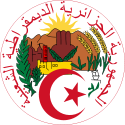
This article is part of the series:
Politics and government of
Algeria
Main article: Politics of AlgeriaAlgeria is an authoritarian regime, according to the Democracy Index 2010.[42] The Freedom of the Press 2009 report gives it rating "Not Free".[43]
The head of state is the president of Algeria, who is elected for a five-year term. The president was formerly limited to two five-year terms but a constitutional amendment passed by the Parliament on 11 November 2008 removed this limitation.[44] Algeria has universal suffrage at 18 years of age.[45] The President is the head of the army, the Council of Ministers the High Security Council. He appoints the Prime Minister who is also the head of government.[46]
The Algerian parliament is bicameral, consisting of a lower chamber, the National People's Assembly (APN), with 380 members; and an upper chamber, the Council Of Nation, with 144 members. The APN is elected every five years.[47]
Under the 1976 constitution (as modified 1979, and amended in 1988, 1989, and 1996), Algeria is a multi-party state. The Ministry of the Interior must approve all parties. To date, Algeria has had more than 40 legal political parties. According to the constitution, no political association may be formed if it is "based on differences in religion, language, race, gender, profession or region". In addition, political campaigns must be exempt from the aforementioned subjects.[48]
Foreign relations and military
Main articles: Foreign relations of Algeria and Military of Algeria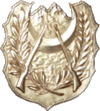 ANP Official badge
ANP Official badge
The military of Algeria consists of the People's National Army (ANP), the Algerian National Navy (MRA), and the Algerian Air Force (QJJ), plus the Territorial Air Defense Force.[45] It is the direct successor of the Armée de Libération Nationale (ALN), the armed wing of the nationalist National Liberation Front, which fought French colonial occupation during the Algerian War of Independence (1954–62). The commander-in-chief of the military is the president, who is also Minister of National Defense.[citation needed]
Total military personnel include 147,000 active, 150,000 reserve, and 187,000 paramilitary staff (2008 estimate).[49] Service in the military is compulsory for men aged 19–30, for a total of 18 months (six training and 12 in civil projects).[45] The total military expenditure in 2006 was estimated variously at 2.7% of GDP (3,096 million),[49] or 3.3% of GDP.[45]
Algeria has its force oriented toward its western (Morocco) and eastern (Libyan) neighbors borders.[citation needed] Its primary military supplier has been the former Soviet Union, which has sold various types of sophisticated equipment under military trade agreements, and the People's Republic of China. Algeria has attempted, in recent years, to diversify its sources of military material. Military forces are supplemented by a 70,000-member gendarmerie or rural police force under the control of the president and 30,000-member Sûreté nationale or metropolitan police force under the Ministry of the Interior.[citation needed]
The Algerian Air Force signed a deal with Russia in 2007, to purchase 49 MiG-29SMT and 6 MiG-29UBT at an estimated $1.9 billion. They also agreed to return old aircraft purchased from the Former USSR. Russia is also building two 636-type diesel submarines for Algeria.[50]
In October 2009, Algeria cancelled a weapons deal with France over the possibility of inclusion of Israeli parts in them.[51]
Tensions between Algeria and Morocco in relation to the Western Sahara have been an obstacle to tightening the Arab Maghreb Union, which was nominally established in 1989 but which has carried little practical weight.[52]
Provinces and districts
Main articles: Provinces of Algeria, Districts of Algeria, and Municipalities of AlgeriaAlgeria is divided into 48 provinces (wilayas), 553 districts (daïras) and 1,541 municipalities (baladiyahs). Each province, district, and municipality is named after its seat, which is usually the largest city. According to the Algerian constitution, a province is a territorial collectivity enjoying some economic freedom.[citation needed]
The People's Provincial Assembly is the political entity governing a province, which has a "president", who is elected by the members of the assembly. They are in turn elected on universal suffrage every five years. The "Wali" (Prefect or governor) directs each province. This person is chosen by the Algerian President to handle the PPA's decisions.[citation needed]
The administrative divisions have changed several times since independence. When introducing new provinces, the numbers of old provinces are kept, hence the non-alphabetical order. With their official numbers, currently (since 1983) they are:[45]
# Wilaya Area (km²) Population map # Wilaya Area (km²) Population 1 Adrar 402,197 439,700 
25 Constantine 2,187 943,112 2 Chlef 4,975 1,013,718 26 Médéa 8,866 830,943 3 Laghouat 25,057 477,328 27 Mostaganem 2,269 746,947 4 Oum El Bouaghi 6,768 644,364 28 M'Sila 18,718 991,846 5 Batna 12,192 1,128,030 29 Mascara 5,941 780,959 6 Béjaïa 3,268 915,835 30 Ouargla 211,980 552,539 7 Biskra 20,986 730,262 31 Oran 2,114 1,584,607 8 Béchar 161,400 274,866 32 El Bayadh 78,870 262,187 9 Blida 1,696 1,009,892 33 Illizi 285,000 54,490 10 Bouïra 4,439 694,750 34 Bordj Bou Arréridj 4,115 634,396 11 Tamanrasset 556,200 198,691 35 Boumerdes 1,591 795,019 12 Tébessa 14,227 657,227 36 El Taref 3,339 411,783 13 Tlemcen 9,061 945,525 37 Tindouf 58,193 159,000 14 Tiaret 20,673 842,060 38 Tissemsilt 3,152 296,366 15 Tizi Ouzou 3,568 1,119,646 39 El Oued 54,573 673,934 16 Algiers 273 2,947,461 40 Khenchela 9,811 384,268 17 Djelfa 66,415 1,223,223 41 Souk Ahras 4,541 440,299 18 Jijel 2,577 634,412 42 Tipaza 2,166 617,661 19 Sétif 6,504 1,496,150 43 Mila 9,375 768,419 20 Saïda 6,764 328,685 44 Ain Defla 4,897 771,890 21 Skikda 4,026 904,195 45 Naâma 29,950 209,470 22 Sidi Bel Abbès 9,150 603,369 46 Ain Timouchent 2,376 384,565 23 Annaba 1,439 640,050 47 Ghardaia 86,105 375,988 24 Guelma 4,101 482,261 48 Relizane 4,870 733,060 Economy
Main article: Economy of AlgeriaThe fossil fuels energy sector is the backbone of Algeria's economy, accounting for roughly 60 percent of budget revenues, 30 percent of GDP, and over 95 percent of export earnings. The country ranks 14th[when?] in petroleum reserves, containing 11.8 billion barrels (1.88×109 m3) of proven oil reserves with estimates suggesting that the actual amount is even more. The U.S. Energy Information Administration reported that in 2005, Algeria had 160 trillion cubic feet (4.5×1012 m3) of proven natural-gas reserves,[53] the tenth largest in the world.[54] Average annual non-hydrocarbon GDP growth averaged 6 percent between 2003 and 2007, with total GDP growing at an average of 4.5 percent during the same period due to less-buoyant oil production during 2006 and 2007. External debt has been virtually eliminated, and the government has accumulated large savings in the oil-stabilization fund (FRR). Inflation, the lowest in the region, has remained stable at four percent on average between 2003 and 2007.[55]
Algeria's financial and economic indicators improved during the mid-1990s, in part because of policy reforms supported by the International Monetary Fund and debt rescheduling from the Paris Club.[citation needed] Algeria's finances in 2000 and 2001 benefited from an increase in oil prices and the government's tight fiscal policy, leading to a large increase in the trade surplus, record highs in foreign exchange reserves, and reduction in foreign debt.[citation needed]
The government's continued efforts to diversify the economy by attracting foreign and domestic investment outside the energy sector have had little success in reducing high unemployment and improving living standards, however. In 2001, the government signed an Association Treaty with the European Union that will eventually lower tariffs and increase trade. In March 2006, Russia agreed to erase $4.74 billion of Algeria's Soviet-era debt[56] during a visit by Russian President Vladimir Putin to the country, the first by a Russian leader in half a century. In return, Algerian President Abdelaziz Bouteflika agreed to buy $7.5 billion worth of combat planes, air-defense systems and other arms from Russia, according to the head of Russia's state arms exporter Rosoboronexport.[57][58]
Algeria also decided in 2006 to pay off its full $8 billion (£4.3 billion) debt to the Paris Club group of rich creditor nations before schedule.[citation needed] This would reduce the Algerian foreign debt to less than $5 billion in the end of 2006. The Paris Club said the move reflected Algeria's economic recovery in recent years.[citation needed]
Agriculture
Main article: Agriculture in AlgeriaAlgeria has always been noted for the fertility of its soil. 14 percent of its labor force are employed in the agricultural sector.[45]
A considerable amount of cotton was grown at the time of the United States' Civil War, but the industry declined afterwards. In the early years of the 20th century efforts to extend the cultivation of the plant were renewed. A small amount of cotton is also grown in the southern oases. Large quantities of dwarf palm are cultivated for the leaves, the fibers of which resemble horsehair. The olive (both for its fruit and oil) and tobacco are cultivated with great success.[citation needed]
More than 30,000 km2 (7,000,000 acres) are devoted to the cultivation of cereal grains. The Tell Atlas is the grain-growing land. During the time of French rule its productivity was increased substantially by the sinking of artesian wells in districts which only required water to make them fertile. Of the crops raised, wheat, barley and oats are the principal cereals. A great variety of vegetables and fruits, especially citrus products, are exported. Algeria also exports figs, dates, esparto grass, and cork.
Demographics
Main article: Demographics of AlgeriaAs of a January 2010 estimate, Algeria's population was 34.9 million, with 99 percent classified ethnically as Arab or Berber.[45] At the outset of the 20th century, its population was approximately four million.[59] About 90 percent of Algerians live in the northern, coastal area; the minority who inhabit the Sahara desert are mainly concentrated in oases, although some 1.5 million remain nomadic or partly nomadic. More than 25 percent of Algerians are under the age of 15.[45]
Most Algerians have Arab, Berber, and to a lesser extent, southern European and sub-Saharan African ancestry. Furthermore, the country has a diverse population ranging from light-skinned, gray-eyed Chaoui and blue-eyed Kabyles in the Atlas Mountains to very dark-skinned populations in the Sahara (e.g., the Tuaregs and Gnawa). Descendants of Andalusian refugees are also present in the population of Algiers and other cities.[60]
Linguistically, approximately 83 percent of Algerians speak Algerian Arabic, while approximately 27 percent speak one of the Berber languages [citation needed] mainly found in the Kabyle and Chaoui regions. French is widely understood, and Standard Arabic (Foshaa) is taught to and understood by most Algerian-Arabic-speaking youth.
Europeans account for less than one percent of the population, inhabiting almost exclusively the largest metropolitan areas. However, during the colonial period there was a large (15.2 percent in 1962) European population, consisting primarily of French people, in addition to Spaniards in the west of the country, Italians and Maltese in the east, and other Europeans such as Greeks in smaller numbers. Known as Pieds-Noirs, European colonists were concentrated on the coast and formed a majority of the population of Oran (60 percent) and important proportions in other large cities including Algiers and Annaba. Almost all of this population left during or immediately after the country's independence from France.[61]
Housing and medicine shortages continue to be pressing problems in Algeria. Failing infrastructure and the continued influx of people from rural to urban areas has overtaxed both systems. According to the United Nations Development Programme, the country has one of the world's-highest per-housing-unit occupancy rates for housing, and government officials have publicly stated that the country has an immediate shortfall of 1.5 million housing units.[citation needed]
Women make up 70 percent of the country's lawyers and 60 percent of its judges, and also dominate the field of medicine. Increasingly, women are contributing more to household income than men. Sixty percent of university students are women, according to university researchers.[62]
It is estimated that 95,700 refugees and asylum-seekers have sought refuge in Algeria. This includes roughly 90,000 from Morocco and 4,100 from Palestine.[63] An estimated 46,000[64] Sahrawis from Western Sahara live in refugee camps in the Algerian part of the Sahara desert.[65][66] As of 2009[update], 35,000 Chinese migrant workers lived in Algeria.[67]
Ethnic groups
Main article: Ethnic groups in AlgeriaAlmost all Algerians are Berber in origin (not Arabs),[45][68][69][70][71][72] the Arab ethnic presence in the country is mainly due to the Phoenicians and Hilallians migratory movements (3rd century BC and 11th century, respectively). However, the majority of Arabized Berber claims an Arab heritage, which is a consequence of the Arab nationalism of the early 20th century. The Berbers are divided into many groups with varying languages. The largest of these are the Kabyles, who live in the Kabylia Mountains east of Algiers. The Chaoui of North-East Algeria, and the Tuaregs in the southern desert..[73] Another historical migratory movements that made the actual Algerians was the Vandalic invasion of the 5th century,[74] and the Mediterranean trade of the 16th-19th century.
Languages
Main article: Languages of AlgeriaThe official language of Algeria is Modern Standard Arabic, as specified in its constitution since 1963. In addition to this, Berber has been recognized as a "national language" by constitutional amendment since 8 May 2002. Between them, these two languages are the native languages of over 99 percent of Algerians, with colloquial Algerian Arabic spoken by about 83 percent (including bilingual Berbers) and Berber by 45 percent (excluding Berber-Arabic bilinguals) .[75] French, though it has no official status, is still widely used in government, culture, media (newspapers) and education (taught from primary school), due to Algeria's colonial history and can be regarded as being the de facto co-official language of Algeria. The Kabyle language, the most-spoken Berber language in the country, is taught and partially co-official (with a few restrictions) in parts of Kabylia. Algerian cities have commonly been given Berber and ancient Roman names.[citation needed]
Religion
The Basilica St. Augustine in Annaba built not far from the remains of his Basilica Pacis Main article: Religion in Algeria
Main article: Religion in AlgeriaIslam is the predominant religion with 99 percent of the population.[45] Almost all Algerian Muslims follow Sunni Islam, with the exception of some 200,000 Ibadis in the M'zab Valley in the region of Ghardaia.[76]
There are also some 250,000 Christians in the country, including about 10,000 Roman Catholics and 150,000 to 200,000 evangelical Protestants (mainly Pentecostal), according to the Protestant Church of Algeria's leader Mustapha Krim[citation needed]. Most of them live in Kabylia area where there are more than seventy underground churches[citation needed]. The nation has experienced a decline in Christianity as a result of Islamization for over a millennium.[citation needed]
Algeria had an important Jewish community until the 1960s. Nearly all of this community emigrated following the country's independence, although a very small number of Algerian Jews continue to live in Algiers.[77]
Cities
Main article: List of cities in AlgeriaBelow is a list of the most important Algerian cities:
Largest cities of Algeria
ONS estimates for 2008Rank City Name Province Pop. Rank City Name Province Pop.
Algiers
1 Algiers Algiers Province 4,988,145 11 Biskra Biskra Province 205,608
Constantine
2 Oran Oran Province 2,454,078 12 Bou Saâda M'sila Province 201,263 3 Constantine Constantine Province 943,112 13 Tébessa Tébessa Province 196,537 4 Sétif Sétif Province 609,499 14 Ouargla Ouargla Province 183,238 5 Annaba Annaba Province 317,206 15 Skikda Skikda Province 177,988 6 Blida Blida Province 264,598 16 Béjaïa Béjaïa Province 178,687 7 Batna Batna Province 246,379 17 Bordj Bou Arréridj Bordj Bou Arréridj Province 140,151 8 Chlef Chlef Province 235,062 18 Béchar Béchar Province 167,230 9 Tlemcen Tlemcen Province 221,231 19 Ain Beida Oum El Bouaghi Province 165,627 10 Sidi Bel Abbès Sidi Bel Abbès Province 208,498 20 Médéa Médéa Province 155,852 Health
Main article: Health in AlgeriaIn 2002, Algeria had inadequate numbers of physicians (1.13 per 1,000 people), nurses (2.23 per 1,000 people), and dentists (0.31 per 1,000 people). Access to "improved water sources" was limited to 92 percent of the population in urban areas and 80 percent of the population in rural areas. Some 99 percent of Algerians living in urban areas, but only 82 percent of those living in rural areas, had access to "improved sanitation". According to the World Bank, Algeria is making progress toward its goal of "reducing by half the number of people without sustainable access to improved drinking water and basic sanitation by 2015". Given Algeria's young population, policy favors preventive health care and clinics over hospitals. In keeping with this policy, the government maintains an immunization program. However, poor sanitation and unclean water still cause tuberculosis, hepatitis, measles, typhoid fever, cholera and dysentery. The poor generally receive health care free of charge.
 This article incorporates public domain material from websites or documents of the Library of Congress Country Studies.- Algeria
This article incorporates public domain material from websites or documents of the Library of Congress Country Studies.- Algeria
Education
Main articles: Education in Algeria and List of universities in AlgeriaEducation is officially compulsory for children between the ages of six and 15. Approximately 5% of the adult population of the country is illiterate.[78]
In Algeria there are 46 universities, 10 colleges, and 7 institutes for higher learning. The University of Algiers was founded in 1909, and its students contributed to the total 267,142 students that were enrolled in Algerian universities in 1996.[79] The Algerian school system is structured into Basic, General Secondary, and Technical Secondary levels:[citation needed]
- Basic
- Ecole fondamentale (Fundamental School)
Length of program: nine years
Age range: six to 15
Certificate/diploma awarded: Brevet d'Enseignement Moyen B.E.M.[citation needed] - General Secondary
- Lycée d'Enseignement général (School of General Teaching), lycées polyvalents (General-Purpose School)
Length of program: three years
Age range: 15 to 18
Certificate/diploma awarded: Baccalauréat de l'Enseignement secondaire
(Bachelor's Degree of Secondary School)[citation needed] - Technical Secondary
- Lycées d'Enseignement technique (Technical School)
Length of program: three years
Certificate/diploma awarded: Baccalauréat technique (Technical Bachelor's Degree)[citation needed]
Culture
Main article: Culture of AlgeriaModern Algerian literature, split between Arabic, Kabyle and French, has been strongly influenced by the country's recent history. Famous novelists of the 20th century include Mohammed Dib, Albert Camus, Kateb Yacine and Ahlam Mosteghanemi while Assia Djebar is widely translated. Among the important novelists of the 1980s were Rachid Mimouni, later vice-president of Amnesty International, and Tahar Djaout, murdered by an Islamist group in 1993 for his secularist views.[80]
In philosophy and the humanities, Jacques Derrida, the father of deconstruction, was born in El Biar in Algiers; Malek Bennabi and Frantz Fanon are noted for their thoughts on decolonization; Augustine of Hippo was born in Tagaste (modern-day Souk Ahras); and Ibn Khaldun, though born in Tunis, wrote the Muqaddima while staying in Algeria. Algerian culture has been strongly influenced by Islam, the main religion. The works of the Sanusi family in pre-colonial times, and of Emir Abdelkader and Sheikh Ben Badis in colonial times, are widely noted. The Latin author Apuleius was born in Madaurus (Mdaourouch), in what later became Algeria.[citation needed]
 Algerian shops, by Louis Comfort Tiffany
Algerian shops, by Louis Comfort Tiffany
In painting, Mohammed Khadda[81] and M'hamed Issiakhem have been notable in recent years.[citation needed]
Cinema
Main article: Cinema of AlgeriaIt was in the midst of the war of liberation that Algerian cinema was born. Despite low echoes in the Western programs, it contains works yet worthy of fame, especially those of Rouiched, Athmane Ariouet or Hadj Abderrahman and Mohammed Lakhdar-Hamina's great movie Chronicle of the Years of Fire, which won the 1975 Palme d'Or at the Cannes Film Festival. The Algerian cinema led development through festivals and other cultural activities. Yet Algerian cinema holds the only Arabic Oscar for Best Foreign Language Film (Costa Gavras's Z, released in 1969).
Cuisine
Main article: Algerian cuisineLiterature
Main articles: Algerian literature and List of Algerian writersMusic
Main article: Music of AlgeriaSports
Main article: Sport in AlgeriaLandscapes and monuments
Zighout Youcef Street in Algiers (north)Roman ruins of Timgad (northeast)El-Kantara in Biskra (south)Mt. Tahat in the Ahaggar Mountains (far south) – highest point in the country (3003m)Sunset in AlgiersGantret El'Hwa in ConstantineThe Casbah of Algiers BathsAnnaba BeachUNESCO World Heritage Sites
There are several UNESCO World Heritage Sites in Algeria[82] including Al Qal'a of Beni Hammad, the first capital of the Hammadid empire; Tipasa, a Phoenician and later Roman town; and Djémila and Timgad, both Roman ruins; M'Zab Valley, a limestone valley containing a large urbanized oasis; also the Casbah of Algiers is an important citadel. The only natural World Heritage Sites is the Tassili n'Ajjer, a mountain range.
Affiliations
Algeria is a member of the following organizations:[45]
Organization Dates United Nations since 10 August 1962 Arab League since 16 August 1962 Organisation of Islamic Cooperation since 1969 Organisation of African Unity since 25 May 1963 See also
- Outline of Algeria
- Index of Algeria-related articles
Notes
- ^ In Algeria, Tamazight has been constitutionally recognized as a national language. The Algerian government recognizes that the varieties of Berber languages in Algeria are national and regional languages which must be presereved. Algeria's official name in Berber is as follows:
- Berber languages, Tifinagh script: ⵜⴰⴳⴷⵓⴷⴰ ⵜⴰⵎⴳⴷⴰⵢⵜ ⵜⴰⵖⴻⵔⴼⴻⵏⵜ ⵜⴰⵣⴰⵢⵔⵉⵜ
References
- ^ (28 November 1996). Constitution of Algeria, Art. 11 (in Arabic).Office of President of Algeria. Retrieved 15 September 2011.
- ^ (28 November 1996). Constitution of Algeria Art. 11. Office of President of Algeria. Retrieved 15 September 2011.
- ^ (28 November 1996). Constitution of Algeria Art. 3. Office of President of Algeria. Retrieved 21 September 2011.
- ^ Staff (2010) (PDF format; requires Adobe Reader). Population and HIV/AIDS 2010. Population Division of the United Nations Department of Economic and Social Affairs. ISBN 978-92-1-151474-2. http://www.un.org/esa/population/publications/population-hiv2010/population-hiv2010chart.pdf. Retrieved 15 September 2011.
- ^ a b c d Database (September 2011). "5. Report for Selected Countries and Subjects". World Economic Outlook Database. International Monetary Fund. http://www.imf.org/external/pubs/ft/weo/2011/02/weodata/weorept.aspx?sy=2008&ey=2011&scsm=1&ssd=1&sort=country&ds=.&br=1&c=612&s=NGDPD%2CNGDPDPC%2CPPPGDP%2CPPPPC%2CLP&grp=0&a=&pr.x=43&pr.y=19. Retrieved 8 October 2011.
- ^ Staff (undated). "Distribution of Family Income – Gini Index". The World Factbook. Central Intelligence Agency. Archived from the original on 23 July 2010. https://www.cia.gov/library/publications/the-world-factbook/fields/2172.html. Retrieved 1 September 2009.
- ^ "Human Development Report 2011. Human Development Index Trends". United Nations. http://hdr.undp.org/en/media/HDR_2011_EN_Table1.pdf. Retrieved 2 November 2011.
- ^ Staff (10 April 2010). "Présentation de l'Algérie" (["Presentation of Algeria"]) (in French). French Ministry of Foreign and European Affairs. Retrieved 15 September 2011.
- ^ "L'Algérie crée une académie de la langue amazigh" (in French).
- ^ "La mondialisation, une chance pour la francophonie" (in French).
- ^ Radicati di Brozolo, Luca G. (1990). "Benemar v. Embassy of the Democratic and Popular Republic of Algeria". American Journal of International Law 84 (2): 573–577. doi:10.2307/2203476.
- ^[Full citation needed] Encarta MSN.
- ^ Staff (undated). "Population et Démographie [Population and Democraphics]" (in French). Algerian Office of National Statistics. http://www.ons.dz/-Population-et-Demographie-.html. Retrieved 15 September 2011.
- ^ al-Idrisi, Muhammad (12th century). Nuzhat al-Mushtaq.
- ^ Abderahman, Abderrahman (1377). History of Ibn Khaldun - Volume 6.
- ^ Ibn Khaldun, Abderahman. "Volume 6". History of Ibn Khaldun.
- ^ Brett, Michael; Fentress, Elizabeth (1997). many29 "Berbers in Antiquity". The Berbers. Wiley-Blackwell. ISBN 978-0-631-20767-2. http://books.google.com/?id=8Zcz91t29ukC&dq=The+Berbers+%28The+Peoples+of+Africaand many29. Retrieved 2 February 2010.
- ^ Khaldūn, Ibn (1852) (in French). Histoire des Berbères et des dynasties musulmanes de l'Afrique Septentrionale Par Ibn Khaldūn, William MacGuckin Slane. pp. XV. http://books.google.com/?id=H3RBAAAAIAAJ&pg=PR2&dq=in+khaldoun#PPR15,M1. Retrieved 28 February 2009.
- ^ Khaldūn, Ibn (1852) (in French). Histoire des Berbères et des dynasties musulmanes de l'Afrique Septentrionale Par Ibn Khaldūn, William MacGuckin Slane [istory of the Berbers and the Muslim dynasties of northern Africa]. pp. X. http://books.google.com/?id=H3RBAAAAIAAJ&pg=PR115&dq=ibn+khaldoun#PPR10,M1. Retrieved 28 February 2009.
- ^ "Barbary Pirates—Encyclopaedia Britannica, 1911". Penelope.uchicago.edu. http://penelope.uchicago.edu/Thayer/E/Gazetteer/Topics/history/American_and_Military/Barbary_Pirates/Britannica_1911*.html. Retrieved 23 April 2010.
- ^ "British Slaves on the Barbary Coast". http://www.bbc.co.uk/history/british/empire_seapower/white_slaves_02.shtml.
- ^ Hitchens, Christopher (Spring 2007). "Jefferson Versus the Muslim Pirates". City Journal. http://www.city-journal.org/html/17_2_urbanities-thomas_jefferson.html. Retrieved 15 September 2011.
- ^ "The Mysteries and Majesties of the Aeolian Islands". International Herald Tribune. http://www.iht.com/articles/2003/09/26/trsic_ed3_.php.
- ^ "Vieste". http://www.centrovacanzeoriente.it/cvoriente/en/dintorni.jsp.
- ^ "History of Menorca". http://www.holidays2menorca.com/history.php.
- ^ "When Europeans were slaves: Research suggests white slavery was much more common than previously believed". http://researchnews.osu.edu/archive/whtslav.htm.
- ^ "Watch-Towers and Fortified Towns". http://www.elbacomunico.com/inglese/pirates.htm.[dead link]
- ^ Rees Davies, "British Slaves on the Barbary Coast". BBC. 1 July 2003.
- ^ Mackie, Erin Skye, Welcome the Outlaw: Pirates, Maroons, and Caribbean Countercultures Cultural Critique – 59, Winter 2005, pp. 24–62
- ^ "Barbary Pirates – Encyclopedia Britannica". http://penelope.uchicago.edu/Thayer/E/Gazetteer/Topics/history/American_and_Military/Barbary_Pirates/Britannica_1911*.html.
- ^ Davis, Robert (2004). Christian Slaves, Muslim Masters – White Slavery in the Mediterranean, the Barbary Coast and Italy, 1500–1800 (via Google Books). ISBN 978-1-4039-4551-8.
- ^ Alistair Horne, (2006). A Savage War of Peace: Algeria 1954–1962 (New York Review Books Classics). 1755 Broadway, New York, NY 10019: NYRB Classics. pp. 29–30. ISBN 978-1-59017-218-6.
- ^[clarification needed] Gallica.bnf.fr. La démographie figurée de l'Algérie (in French). op. cit.. pp. 260–261.
- ^ Randell, Keith. France – Republic, Monarchy, and Empire.
- ^ Horne, Alistair (2006). A Savage War of Peace: Algeria 1954–1962 (New York Review Books Classics). 1755 Broadway, New York, NY 10019: NYRB Classics. p. 32. ISBN 978-1-59017-218-6.
- ^ "Country Data". Country-data.com. http://www.country-data.com/cgi-bin/query/r-365.html. Retrieved 24 November 2008.
- ^ Smith, Andrea L. (2006). Colonial Memory and Postcolonial Europe. Indiana University Press.
- ^ "French 'Reparation' for Algerians". BBC News. 6 December 2007. http://news.bbc.co.uk/2/hi/europe/7130307.stm.
- ^ Arabic German Consulting www.Arab.de. Retrieved 4 April 2006.
- ^ "Algeria Officially Lifts State of Emergency". CNN. 24 February 2011. http://articles.cnn.com/2011-02-24/world/algeria.emergency_1_islamist-party-algerian-press-service-emergency-declaration?_s=PM:WORLD. Retrieved 27 February 2011.
- ^ MHerrera.org and Burt, Christopher C. (2007). Extreme Weather – A Guide and Record Book. W.W. Norton Press. Archived 10 January 2010 at WebCite
- ^ "Democracy Index 2010". http://graphics.eiu.com/PDF/Democracy_Index_2010_web.pdf.
- ^ "Freedom of the Press 2009". Freedom House. http://www.freedomhouse.org/uploads/fop/2009/FreedomofthePress2009_tables.pdf. Retrieved 7 May 2009.
- ^ "Algeria Deputies Scrap Term Limit". BBC News. 12 November 2008. http://news.bbc.co.uk/2/hi/africa/7724635.stm. Retrieved 24 November 2008.
- ^ a b c d e f g h i j k l "Africa: Algeria". The World Factbook. Central Intelligence Agency. Archived from the original on 17 January 2010. https://www.cia.gov/library/publications/the-world-factbook/geos/ag.html. Retrieved 7 December 2009.
- ^ Articles: 85, 87, 77, 78 and 79 of the Algerian constitution Algerian government. "Constitution". http://www.conseil-constitutionnel.dz/Constitution08_6.htm. Retrieved 25 September 2011.
- ^ Article 102 of the Algerian constitution
- ^ Article 42 of the Algerian constitution - Algerian Government. "Algerian constitution الحـقــوق والحــرّيـات". http://www.conseil-constitutionnel.dz/Constitution08_4-1.htm. Retrieved 25 September 2011.
- ^ a b Hackett, James (ed.) (5 February 2008). The Military Balance 2008. International Institute for Strategic Studies. Europa. ISBN 978-1-85743-461-3. http://www.zawya.com/printstory.cfm?storyid=v51n20-1TS05&l=134200080519. Retrieved 16 July 2008.
- ^ "Venezuela's Chavez To Finalise Russian Submarines Deal". Agence France-Presse (via Breitbart.com). 14 June (unknown year). http://www.breitbart.com/article.php?id=070614062644.0d1z4l69&show_article=1. Retrieved 31 August 2011.
- ^ "Algeria Cancels Weapons Deal over Israeli Parts". Info Prod Research. Archived from the original on 2010-01-01. http://web.archive.org/web/20100101035737/http://www.infoprod.co.il/article/2/301. Retrieved 23 April 2010.
- ^ "Bin Ali calls for reactivating Arab Maghreb Union, Tunisia-Maghreb, Politics". ArabicNews.com. 1999-02-19. http://www.arabicnews.com/ansub/Daily/Day/990219/1999021906.html. Retrieved 2006-04-04.
- ^ Table (undated). "Country Comparison :: Natural Gas – Proved Reserves". The World Factbook. Central Intelligence Agency. Retrieved 31 August 2011.
- ^ "Algeria Country Analysis Brief". Energy Information Administration. 2005-03. Archived from the original on 2007-01-17. http://web.archive.org/web/20070117162701/http://www.eia.doe.gov/emeu/cabs/algeria.html. Retrieved 2007-01-18.
- ^ Staff (undated). "Algeria: Financial Sector Profile". Making Finance Work for Africa. Retrieved 31 August 2011.
- ^ "Brtsis, Brief on Russian Defence, Trade, Security and Energy". Brtsis.com. Archived from the original on 2008-02-19. http://web.archive.org/web/20080219035941/http://www.brtsis.com/. Retrieved 24 November 2008.
- ^[dead link] "Russia Agrees Algeria Arms Deal, Writes Off Debt". Reuters. 11 March 2006. http://za.today.reuters.com/news/NewsArticle.aspx?type=businessNews&storyID=2006-03-11T082958Z_01_BAN130523_RTRIDST_0_OZABS-ECONOMY-RUSSIA-ALGERIA-20060311.XML.
- ^ Marsaud, Olivia (10 March 2006). "La Russie efface la dette algérienne" (in French). Radio France Internationale. http://www.rfi.fr/actufr/articles/075/article_42379.asp. Retrieved 31 August 2011.
- ^ "Algeria – Population". Library of Congress Country Studies.
- ^ Ruedy, John Douglas (2005). Modern Algeria – The Origins and Development of a Nation (via Google Books). Indiana University Press. p. 22. ISBN 978-0-253-21782-0.
- ^ De Azevedo, Raimond Cagiano (1994). Migration and Development Co-Operation. Council of Europe (via Google Books). p. 25. ISBN 978-92-871-2611-5.
- ^ Slackman, Michael (26 May 2007). "A Quiet Revolution in Algeria: Gains by Women". The New York Times. http://www.nytimes.com/2007/05/26/world/africa/26algeria.html. Retrieved 29 August 2011.
- ^ "World Refugee Survey 2008". U.S. Committee for Refugees and Immigrants. p. 34. Archived from Refugees.org the original on 2011-01-26. http://web.archive.org/web/20110126130045/http://www.refugees.org/countryreports.aspx?id=2116.
- ^ "Home: Only 46,000 People Benefit from Humanitarian Aid in Tindouf Camps, Says Former Polisario Leader". Map.ma. http://www.map.ma/eng/sections/general/only_46000_people_b/view. Retrieved 27 November 2010.
- ^ Buckley, Cara (4 June 2008). "Western Sahara's Conflict Traps Refugees in Limbo". The New York Times. http://www.nytimes.com/2008/06/04/world/africa/04sahara.html?_r=1&pagewanted=print. Retrieved 29 August 2011.
- ^ Staff (5 September 2007). "Western Sahara: Lack of Donor Funds Threatens Humanitarian Projects". IRIN. Retrieved 5 September 2011.
- ^ Staff (4 August 2009). "Chinese Migrants in Algiers Clash". BBC News. Retrieved 5 September 2011.
- ^ Arredi, Barbara; Poloni, Estella S.; Paracchini, Silvia; Zerjal, Tatiana; Dahmani, M. Fathallah; Makrelouf, Mohamed; Vincenzo, L. Pascali; Novelletto, Andrea et al. (June 7, 2004). A Predominantly Neolithic Origin for Y-Chromosomal DNA Variation in North Africa. http://www.ncbi.nlm.nih.gov/pmc/articles/PMC1216069/. Retrieved 30 October 2011.
- ^ Stokes, Jamie (2009). Encyclopedia of the Peoples of Africa and the Middle East: L to Z. Infobase Publishing. pp. 21. http://books.google.com/books?id=stl97FdyRswC&pg.
- ^ Willem Adriaan Veenhoven, Winifred Crum Ewing, Stichting Plurale Samenlevingen (1975). Case studies on human rights and fundamental freedoms: a world survey, Volume 1. Martinus Nijhoff Publishers. pp. 263. http://books.google.com/books?id=wh3ZUWExDEcC&pg.
- ^ Oxford Business Group (2008). The Report: Algeria 2008. Oxford Business Group. pp. 10. http://books.google.com/books?id=zPz9FHXJVLUC&pg.
- ^ Oxford Business Group (2011). The Report: Algeria 2011. Oxford Business Group. pp. 9. http://books.google.com/books?id=uSGzIPz8cYIC&pg.
- ^ Marion Mill Preminger (1961). The sands of Tamanrasset: the story of Charles de Foucauld. Hawthorn Books. http://books.google.com/books?id=xfCfAAAAMAAJ&q.
- ^ Collins, Roger (2000). "XIV". Vandal Africa, 429–533. Cambridge University Press. pp. 124.
- ^ Leclerc, Jacques (5 April 2009). "Algérie: Situation géographique et démolinguistique" (in French). L'aménagement linguistique dans le monde. Université Laval. http://www.tlfq.ulaval.ca/AXL/AFRIQUE/algerie-1demo.htm. Retrieved 8 January 2010.
- ^[unreliable source?] "Ibadis and Kharijis". (via Angelfire). http://www.angelfire.com/az/rescon/mgcibadi.html. Retrieved 23 April 2010.
- ^ Staff (14 September 2007). "Algeria". 2007 International Religious Freedom Report. Bureau of Democracy, Human Rights, and Labor (via the US State Department). http://www.state.gov/g/drl/rls/irf/2007/90207.htm. Retrieved 5 September 2011.
- ^ "Human Development Report 2009 – Proportion of international migrant stocks residing in countries with very high levels of human development (%)". Hdrstats.undp.org. http://hdrstats.undp.org/en/indicators/20.html. Retrieved 29 December 2009.
- ^ "Algeria – Education". Nationsencyclopedia.com. http://www.nationsencyclopedia.com/Africa/Algeria-EDUCATION.html. Retrieved 24 November 2008.
- ^ Tahar Djaout French Publishers' Agency and France Edition, Inc. Retrieved 4 April 2006.
- ^ Mohammed Khadda official site. Retrieved 4 April 2006.
- ^ UNESCO. "UNESCO World Heritage Centre". http://whc.unesco.org/en/statesparties/dz. Retrieved 25 September 2011.
Bibliography
- Ageron, Charles-Robert (1991). Modern Algeria – A History from 1830 to the Present. Translated from French and edited by Michael Brett. London: Hurst. ISBN 978-0-86543-266-6.
- Aghrout, Ahmed; Bougherira, Redha M. (2004). Algeria in Transition – Reforms and Development Prospects. Routledge. ISBN 978-0-415-34848-5.
- Bennoune, Mahfoud (1988). The Making of Contemporary Algeria – Colonial Upheavals and Post-Independence Development, 1830–1987. Cambridge: Cambridge University Press. ISBN 978-0-521-30150-3.
- Fanon, Frantz (1966; 2005 paperback). The Wretched of the Earth. Grove Press. ASIN B0007FW4AW, ISBN 978-0-8021-4132-3.
- Horne, Alistair (1977). A Savage War of Peace: Algeria 1954–1962. Viking Adult. ISBN 978-0-670-61964-1, ISBN 978-1-59017-218-6 (2006 reprint)
- Laouisset, Djamel (2009). A Retrospective Study of the Algerian Iron and Steel Industry. New York City: Nova Publishers. ISBN 978-1-61761-190-2.
- Roberts, Hugh (2003). The Battlefield – Algeria, 1988–2002. Studies in a Broken Polity. London: Verso Books. ISBN 978-1-85984-684-1.
- Ruedy, John (1992). Modern Algeria – The Origins and Development of a Nation. Bloomington: Indiana University Press. ISBN 978-0-253-34998-9.
- Stora, Benjamin (2001). Algeria, 1830–2000 – A Short History. Ithaca, New York: Cornell University Press. ISBN 978-0-8014-3715-1.
- Sidaoui, Riadh (2009). "Islamic Politics and the Military – Algeria 1962–2008". Religion and Politics – Islam and Muslim Civilisation (via Google Books). Farnham: Ashgate Publishing. ISBN 0-7546-7418-5.
External links
- People's Democratic Republic of Algeria official government website
- Algeria entry at The World Factbook
- Algeria web resources provided by GovPubs at the University of Colorado–Boulder Libraries
- Algeria at the Open Directory Project
- Wikimedia Atlas of Algeria
- Algeria travel guide from Wikitravel

Mediterranean Sea Mediterranean Sea Mediterranean Sea 











 Categories:
Categories:- Algeria
- Arabic-speaking countries and territories
- Countries of the Mediterranean Sea
- French-speaking countries
- G15 nations
- Member states of the African Union
- Member states of the Arab League
- Member states of OPEC
- Member states of the Organisation of Islamic Cooperation
- Member states of the Union for the Mediterranean
- Member states of the United Nations
- Northern African countries
- Republics
- States and territories established in 1962
Wikimedia Foundation. 2010.

